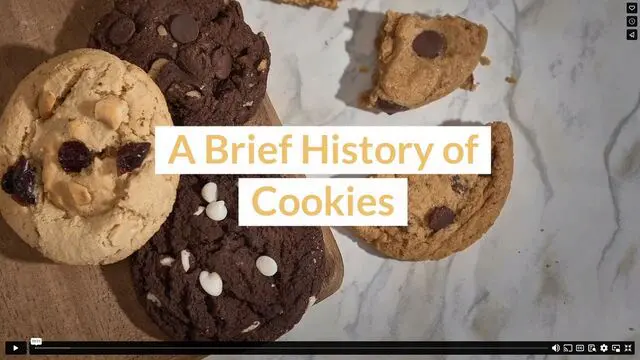5 interesting facts about how cookies came to be
For as long as anyone alive can remember, cookies have been around. Whether it’s to decorate sugar cookies around the holidays or to enjoy an assortment of cookies as a party refreshment, cookies are a part of the abundant life.
But where do cookies originate from? Who came up with the idea for these delectable little treats? Stick with us as we take you on a quick journey through history to reveal five interesting facts about the origin of cookies.

(linesampaio_ / pixabay)
1. What’s in a name?
In the words of Shakespeare, “What’s in a name? A rose by any other name would smell as sweet.” In the same vein, we declare that a cookie by any other name would taste as sweet.
What we refer to as cookies here in the United States are known by various names in other countries worldwide.
For example, in Australia and England, cookies are called biscuits. In Italy, cookies are commonly referred to as amaretti or biscotti. In Spain, these sweet treats are known as galletas. Germans refer to cookies as keks or platzchen.
No matter what you call them, these little desserts are delicious. But where does the name originate? The term cookie is derived from the Dutch word koekje. Koekje means “small cake.”
2. Small Cakes
Merriam-Webster defines cookies as small, flat, or slightly raised cakes. This definition, along with the Dutch word koekje, perfectly describes how cookies came to be.
Way back in history, around 7th Century A.D. in what was then Persia, cake bakers needed a way to tell if their oven was the correct temperature. Since thermostats hadn’t been invented, bakers would put a small amount of cake batter in the oven to test the temperature. This ritual was how cookies were born. (And we have to wonder if being a cake tester was the most coveted job in all of Persia.)
As time went on, cookies were introduced to European countries. Cookies quickly became popular and were quite common in cities throughout Europe by the end of the 14th century.
3. World Traveler
During the 1500s, as people started exploring the world, cookies went along with them. A type of cookie known as hardtack became an ideal food for traveling. Hardtack was a simple, dense type of biscuit with a long storage life—perfect for traveling.
4. Coming to America
As Europeans arrived in the Americas, so did their cookie recipes. Before long, though, these European recipes were adapted to fit life in the New World. An example of this is the American Butter cookie. This simple cookie is similar to a teacake in England and a shortbread in Scotland.
As the railroad in the United States expanded in the 1800s and moved west, cookie recipes in the west started to evolve. With the railroad came the ability for people to purchase more varieties of fruits and nuts, which they added to cookie recipes.
Then came the invention of cereal, modern ovens, thermostats, and refrigerators–all of which drove even more change in the cookie world.
5. Chocolate Chip Cookies
The chocolate chip cookie is a classic American cookie. But, surprisingly, the chocolate chip cookie wasn’t even one of the cookies first invented in the United States. In fact, these tasty favorites were created by accident.
It all started with a woman named Ruth Graves Wakefield, who ran the Toll House Restaurant in Massachusetts. One day, in 1937, Ruth was preparing to make cookies for her guests, as she often did. Ruth planned on making Butter Drop Do cookies, a favorite recipe of hers.
The recipe called for baker’s chocolate, but Ruth was fresh out. However, she did have a bar of Nestle semi-sweet chocolate. Ruth decided to cut the bar into pieces and add them to the dough.
Ruth expected the chocolate to melt during the baking process, but to her surprise, the chocolate pieces kept their shape but softened to a creamy texture. Thus, the chocolate chip cookie was born.
Ruth originally named her new recipe Toll House Crunch Cookies. These cookies quickly became popular, and Ruth’s recipe was published in multiple newspapers. As a result, the sales of Nestle’s semi-sweet chocolate bar increased exponentially.
Eventually, Ruth approached Nestle, and together, they came to an agreement that would benefit them both. Nestle would be able to print Ruth’s recipe on the wrapper of their semi-sweet chocolate bar, and Ruth would be supplied with all the chocolate she would ever need.
The recipe would come to be known as the Toll House Cookie Recipe. In 1939, Nestle introduced Nestle Toll House Real Semi-Sweet Chocolate Morsels. These morsels, or chips as they later became known, are still a favorite for American bakers.
And now you know the rest of the story for one of the most beloved desserts and snacks of all time. It’s hard to believe that early American cookbooks didn’t even have a section dedicated to cookies. Cookie recipes were just simply added at the end of the cake section.
Today, there are hundreds, maybe thousands, of cookie recipes in the United States. You could spend hours online searching for different cookie recipes and amass hundreds of cookies-only cookbooks and still only scratch the surface.
We are sure glad that cookies were invented and that they are easy to come by whenever a craving strikes. Whether you’re enjoying an original butter cookie, a decadent chocolate walnut cookie, a gourmet peanut butter cookie, or anything in between, dedicate a moment of thanks to the events and people along the way that led us to the simple pleasure of the cookie.
Video

